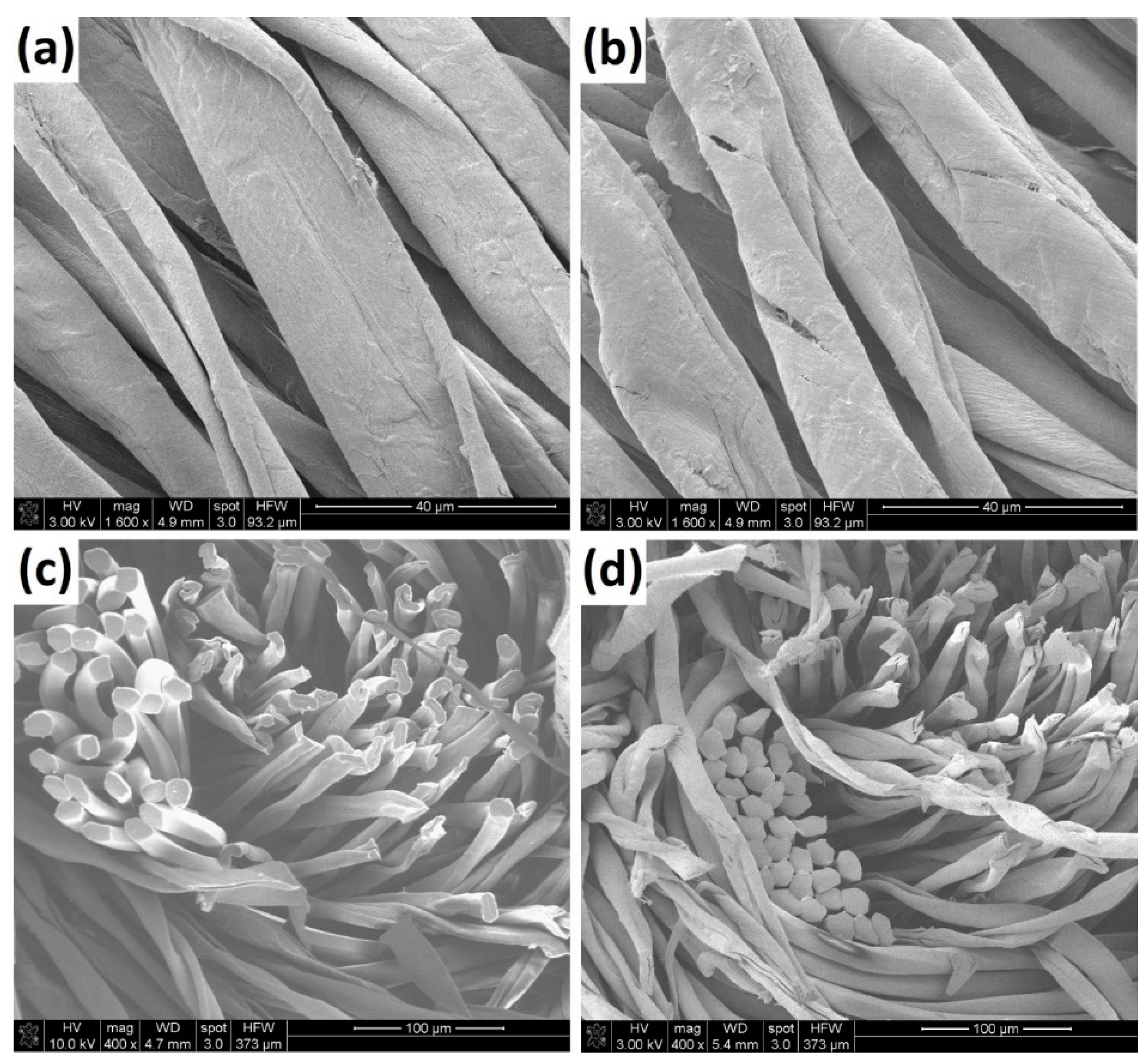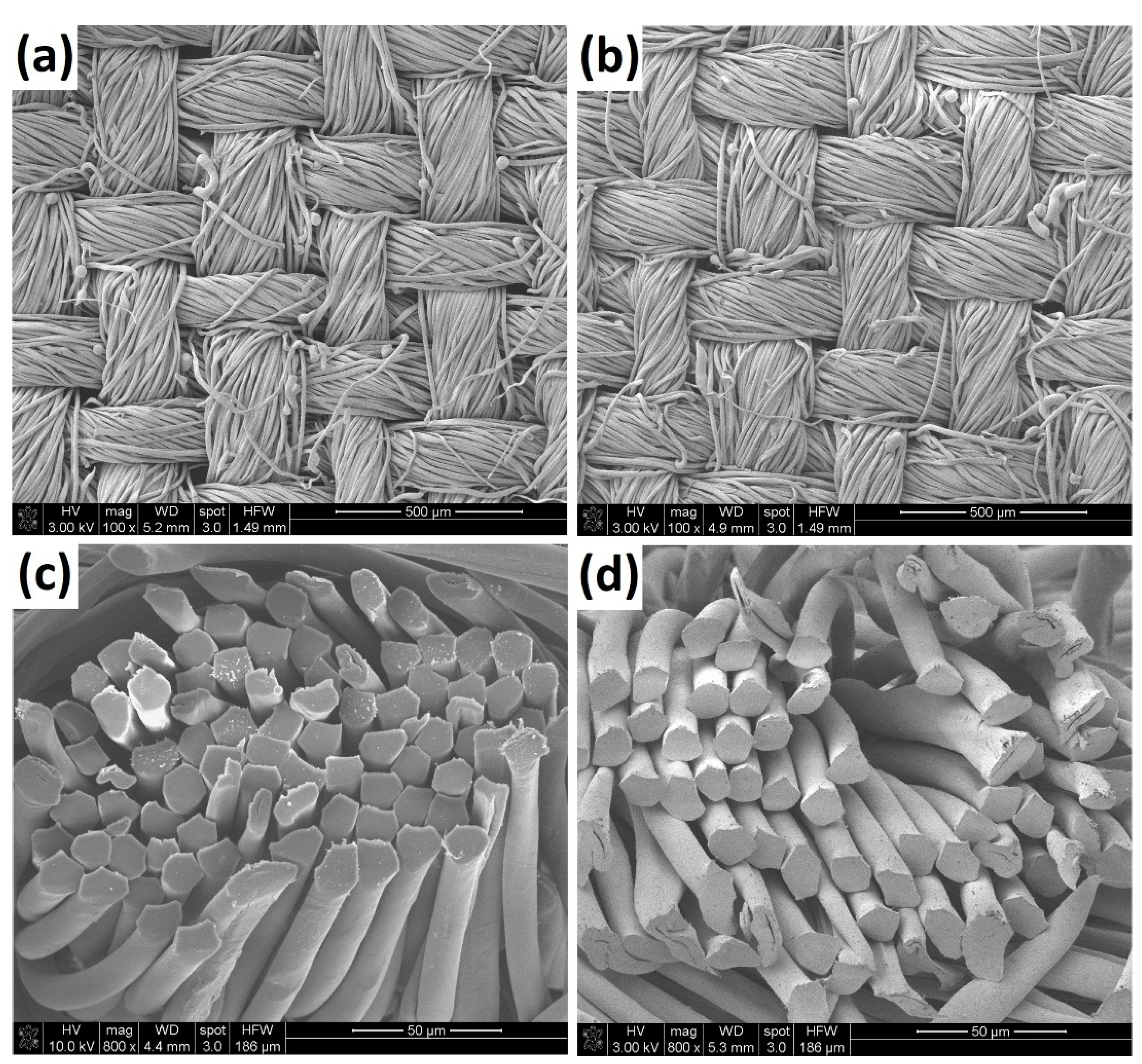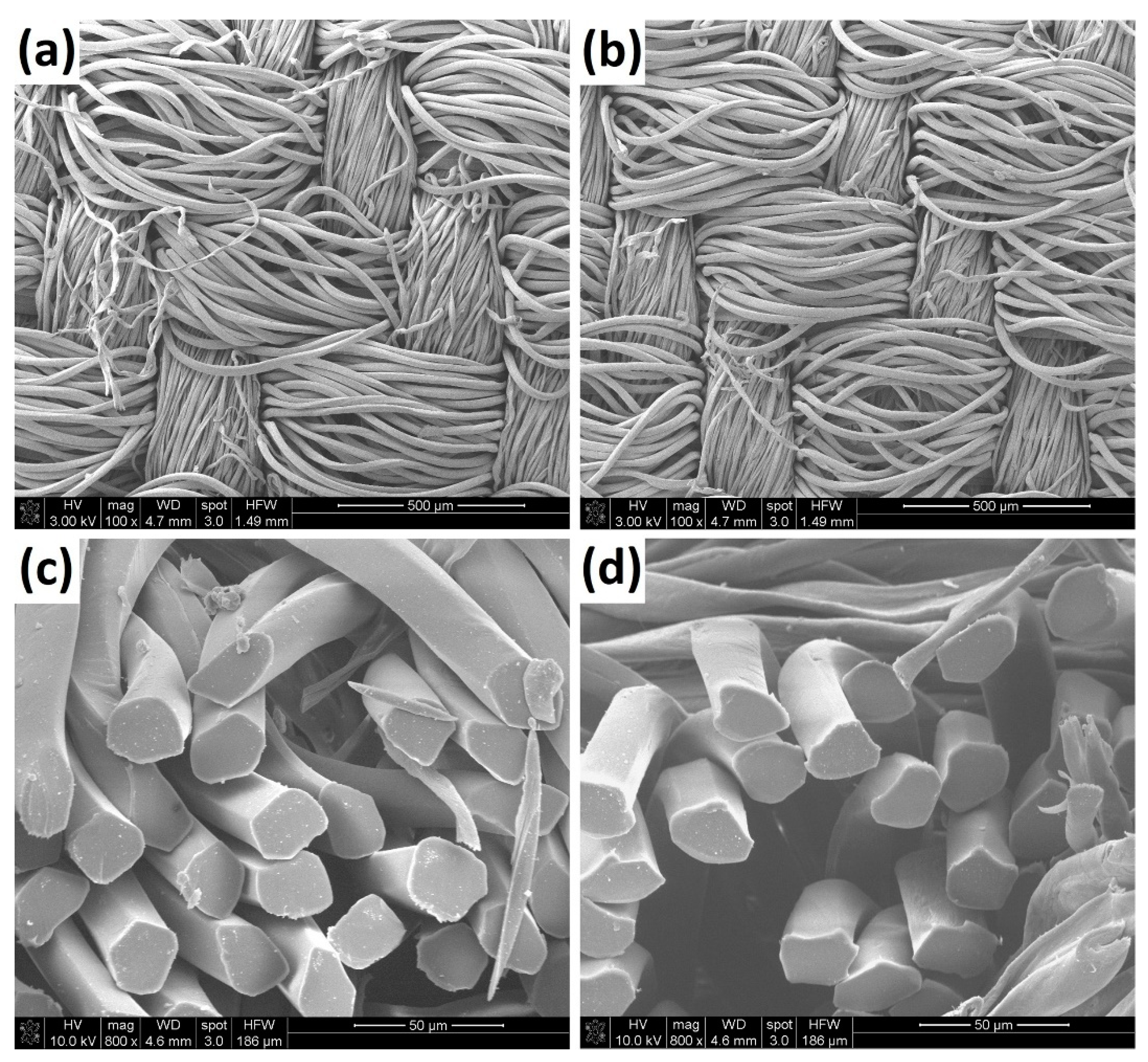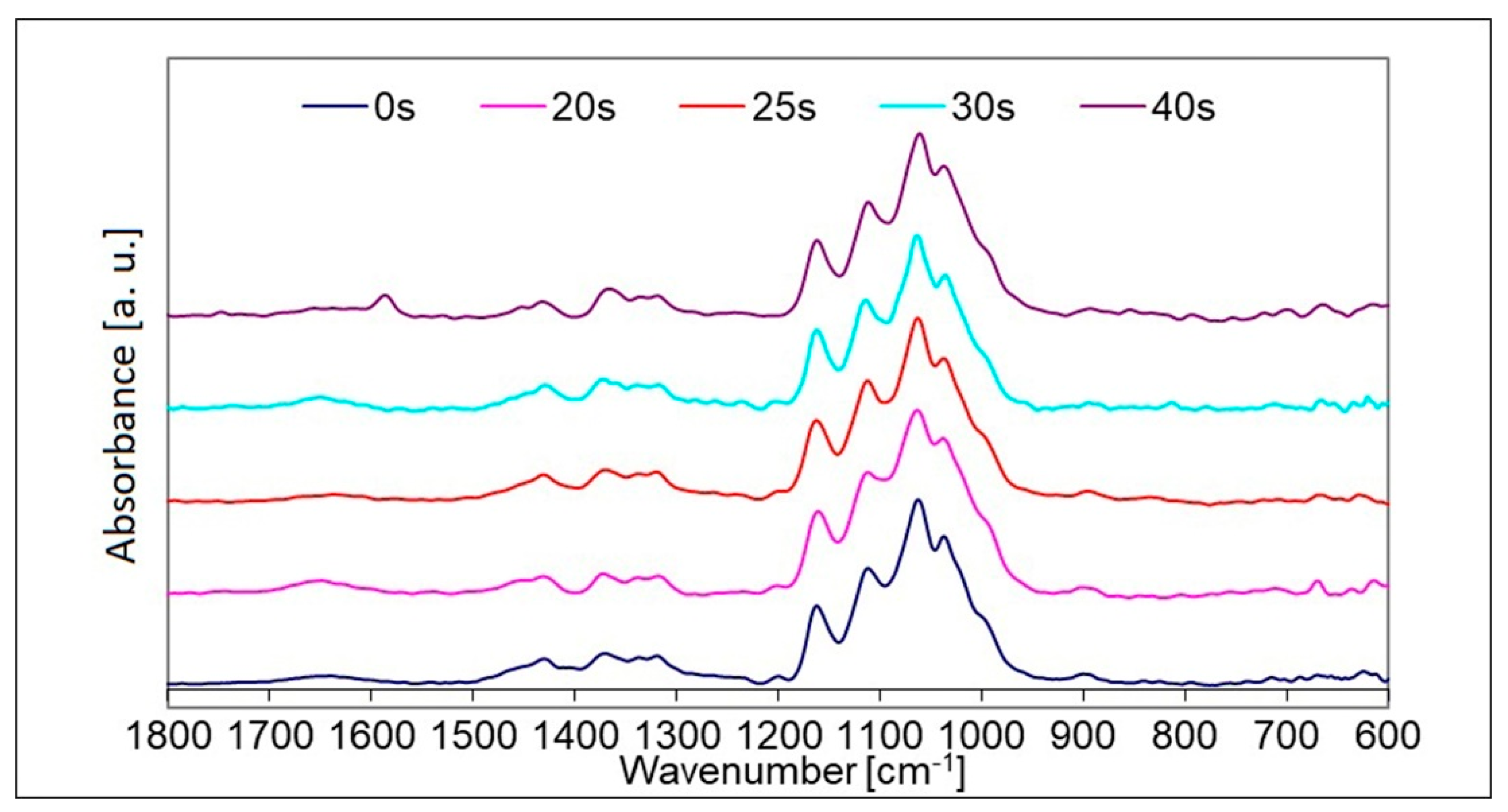Evaluation of Selected Thermal Changes in Textile Materials Arising in the Wake of the Impact of Heat Radiation
Abstract
:1. Introduction
2. Materials and Methods
2.1. Materials
2.2. Exposure of Fabrics to Heat Radiation
2.3. Microscopic Analysis of Fabrics and Fibres
2.4. Micro-FTIR Spectroscopy Analysis of Fibres
3. Results and Discussion
3.1. SEM Analysis
3.2. Optical Microscopy Analysis
3.3. Micro-FTIR Spectroscopy Analysis
4. Conclusions
Author Contributions
Funding
Institutional Review Board Statement
Informed Consent Statement
Data Availability Statement
Acknowledgments
Conflicts of Interest
References
- Azwa, Z.N.; Yousif, B.F.; Manalo, A.C.; Karunasena, W. A review on the degradability of polymeric composites based on natural fibres. Mater. Des. 2013, 47, 424–442. [Google Scholar] [CrossRef] [Green Version]
- Shalaby, S.W. Thermal Characterization of Polymeric Materials; Academic Press: Orlando, FL, USA, 1981. [Google Scholar]
- Nguyen, T.M.; Chang, S.; Condon, B.; Thomas, T.; Azadi, P. Thermal decomposition reactions of cotton fabric treated with piperazine-phosphonates derivatives as a flame retardant. J. Anal. Appl. Pyrolysis 2014, 110, 122–129. [Google Scholar] [CrossRef]
- Cai, Z.; Ji, B.; Yan, K.; Zhu, Q. Investigation on Reaction Sequence and Group Site of Citric Acid with Cellulose Characterized by FTIR in Combination with Two-Dimensional Correlation Spectroscopy. Polymers 2019, 11, 2071. [Google Scholar] [CrossRef] [PubMed] [Green Version]
- Machnowski, W.; Wrzosek, H. Changes in some properties of flame resistant textiles during their use. In Innovative Technical Textiles; Masajtis, J., Ed.; Monography of Lodz University of Technology: Lodz, Poland, 2016. [Google Scholar]
- Barbalini, M.; Bertolla, L.; Toušek, J.; Malucelli, G. Hybrid Silica-Phytic Acid Coatings: Effect on the Thermal Stability and Flame Retardancy of Cotton. Polymers 2019, 11, 1664. [Google Scholar] [CrossRef] [PubMed] [Green Version]
- Liang, S.; Nouri, H.; Lafranche, E. Thermo-compression forming of flax fibre-reinforced polyamide 6 composites: Influence of the fibre thermal degradation on mechanical properties. J. Mater. Sci. 2015, 50, 7660–7672. [Google Scholar] [CrossRef]
- Xu, D.; Ji, Q.; Tan, L.; Tian, G.; Quan, F.; Xia, Y. Influence of Alkaline Metal Ions on Flame Retardancy and Thermal Degradation of Cellulose Fibers. Fibers Polym. 2014, 15, 220–225. [Google Scholar] [CrossRef]
- Kavkler, K.; Gunde-Cimerman, N.; Zalar, P.; Demšar, A. FTIR spectroscopy of biodegraded historical textiles. Polym. Degrad. Stab. 2011, 96, 574–580. [Google Scholar] [CrossRef]
- Gutarowska, B.; Pietrzak, K.; Machnowski, W.; Milczarek, J. Historical textiles—A review of microbial deterioration analysis and disinfection methods. Text. Res. J. 2017, 87, 2388–2406. [Google Scholar] [CrossRef]
- Rossi, R.M. Performance of Firefighters’ Protective Clothing After Heat Exposure. Int. J. Occup. Saf. Ergon. 2008, 14, 55–60. [Google Scholar] [CrossRef]
- Cui, Z.; Ma, C.; Lv, N. Effects of Heat Treatment on the Mechanical and Thermal Performance of Fabric Used in Firefighter Protective Clothing. Fibres Text. East. Eur. 2015, 23, 74–78. [Google Scholar]
- Wąs-Gubała, J.; Krauß, W. Textile damage caused by vapour cloud explosions. Sci. Justice 2004, 44, 209–215. [Google Scholar] [CrossRef]
- Schotman, T.G.; Samlal-Soedhoe, R.S.; Van der Weerd, J. Toward a systematic classification of textile damages. Forensic Sci. Rev. 2018, 30, 51–75. [Google Scholar]
- Was-Gubala, J.; Krauß, W. Damage caused to fibres by the action of two types of heat. Forensic Sci. Int. 2006, 159, 119–126. [Google Scholar] [CrossRef]
- Hearle, J.W.S.; Lomas, B.; Cooke, W.D. Atlas of Fibre Fracture and Damage to Textiles; CRC Press: Boca Raton, FL, USA, 1998. [Google Scholar]
- Brozek-Mucha, Z.; Was-Gubala, J. Microscopic and microanalytical examinations of metallic particles and single textile fibers for forensic purposes. In Microscopy Book; Series Number 5, Volume 2, 1480–1491; Formatex Research Center: Badajoz, Spain, 2012. [Google Scholar]
- Bilkova, L. Application of infrared spectroscopy and thermal analysis to the examination of the degradation of cotton fibers. Polym. Degrad. Stab. 2012, 97, 35–39. [Google Scholar] [CrossRef]
- Yilma, B.B.; Luebben, J.F.; Nalankilli, G. The Effect of Air, Ar and O2 Plasmas on the Electrical Resistivity and Hand-Feel Properties of Polyester/Cotton Blend Fabric. Fibers 2020, 8, 17. [Google Scholar] [CrossRef] [Green Version]
- Soares, S.; Camino, G.; Levchik, S. Effect of metal carboxylates on the thermal decomposition of cellulose. Polym. Degrad. Stab. 1998, 62, 25–31. [Google Scholar] [CrossRef]
- Puszkarz, A.K.; Wojciechowski, J.; Krucińska, I. Analysis of the thermal insulation of textiles using thermography and CFD simulation based on micro-CT models. Autex Res. J. 2020, 20, 344–351. [Google Scholar] [CrossRef]
- Barburski, M.; Straumit, I.; Zhang, X.; Wevers, M.; Lomov, S.V. Micro-CT analysis of internal structure of sheared textile composite reinforcement. Appl. Sci. Manuf. 2015, 73, 45–54. [Google Scholar] [CrossRef]
- Song, G.; Gholamreza, F.; Cao, W. Analyzing thermal stored energy and effect on protective performance. Text. Res. J. 2011, 81, 1124–1138. [Google Scholar] [CrossRef]
- Puszkarz, A.K.; Machnowski, W.; Błasińska, A. Modeling of thermal performance of multilayer protective clothing exposed to radiant heat. Heat Mass Transf. 2020, 56, 1767–1775. [Google Scholar] [CrossRef] [Green Version]
- ISO 5084:1996 Textiles—Determination of Thickness of Textiles and Textile Products; ISO: Geneva, Switzerland, 1996.
- EN 12127:1997 Textiles Fabrics—Determination of Mass per Unit Area Using Small Samples; CEN: Brussels, Belgium, 1997.
- ISO 6942:2002 Protective Clothing—Protection Against Heat and Fire—Method of Test: Evaluation of Materials and Material Assemblies When Exposed to a Source of Radiant Heat; ISO: Geneva, Switzerland, 2002.
- Dechant, J. Ultrarotspektroskopische Untersuchungen an Polymeren; Akademie Verlag: Berlin, Germany, 1972. [Google Scholar]
- Flincec Grgac, S.; Tarbuk, A.; Dekanic, T.; Sujka, W.; Draczynski, Z. The Chitosan Implementation into Cotton and Polyester/Cotton Blend Fabrics. Materials 2020, 13, 1616. [Google Scholar] [CrossRef] [PubMed] [Green Version]
- Zghari, B.; Hajji, L.; Boukir, A. Effect of Moist and Dry Heat Weathering Conditions on Cellulose Degradation of Historical Manuscripts exposed to Accelerated Ageing: 13C NMR and FTIR Spectroscopy as a non-Invasive Monitoring Approach. J. Mater. Environ. Sci. 2018, 9, 641–654. [Google Scholar]
- Cintrón, M.S.; Hinchliffe, D.J. FT-IR Examination of the Development of Secondary Cell Wall in Cotton Fibers. Fibers 2015, 3, 30–40. [Google Scholar] [CrossRef] [Green Version]






| Sample Number | Material Composition | Mass Per Unit Area, g·m−2 | Thickness, mm | Porosity, % | Other Features of Sample |
|---|---|---|---|---|---|
| 1 | 83% CO, 17% PES | 260 ± 5 | 1.25 ± 0.15 | 86 ± 2 | Sweater; knitted fabric with a raised uncut loops of thread covering its outer side |
| 2 | 79% CO, 21% PES | 356 ± 7 | 2.40 ± 0.26 | 90 ± 1 | Pants; pile knit with a cut-pile surface on the outer side |
| 3 | 75% CO, 25% PES | 130 ± 4 | 0.34 ± 0.03 | 74 ± 2 | Shirt; woven fabric with a plain weave |
| 4 | 70% CO, 30% PES | 237 ± 5 | 0.67 ± 0.05 | 76 ± 2 | Pants; woven fabric with a twill weave |
Publisher’s Note: MDPI stays neutral with regard to jurisdictional claims in published maps and institutional affiliations. |
© 2021 by the authors. Licensee MDPI, Basel, Switzerland. This article is an open access article distributed under the terms and conditions of the Creative Commons Attribution (CC BY) license (https://creativecommons.org/licenses/by/4.0/).
Share and Cite
Machnowski, W.; Wąs-Gubała, J. Evaluation of Selected Thermal Changes in Textile Materials Arising in the Wake of the Impact of Heat Radiation. Appl. Sci. 2021, 11, 6989. https://doi.org/10.3390/app11156989
Machnowski W, Wąs-Gubała J. Evaluation of Selected Thermal Changes in Textile Materials Arising in the Wake of the Impact of Heat Radiation. Applied Sciences. 2021; 11(15):6989. https://doi.org/10.3390/app11156989
Chicago/Turabian StyleMachnowski, Waldemar, and Jolanta Wąs-Gubała. 2021. "Evaluation of Selected Thermal Changes in Textile Materials Arising in the Wake of the Impact of Heat Radiation" Applied Sciences 11, no. 15: 6989. https://doi.org/10.3390/app11156989
APA StyleMachnowski, W., & Wąs-Gubała, J. (2021). Evaluation of Selected Thermal Changes in Textile Materials Arising in the Wake of the Impact of Heat Radiation. Applied Sciences, 11(15), 6989. https://doi.org/10.3390/app11156989








